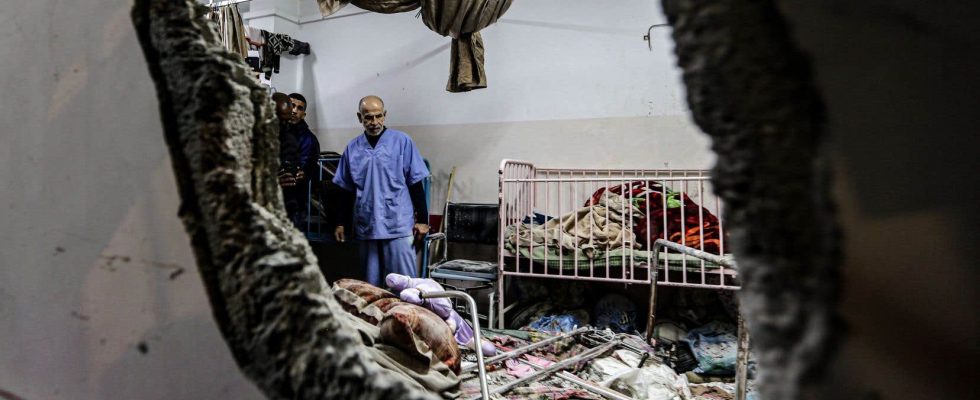The Israeli army announced Thursday that it was carrying out an operation in a large hospital in the south of the Gaza Strip, where it said Hamas hostages were being held and where doctors described a desperate situation.
Under the fire of fighting between the army and the Palestinian Islamist movement, the Nasser hospital in Khan Younes welcomed thousands of civilians fleeing the war, whose evacuation began in recent days.
The army announced that it was carrying out a “targeted and limited operation” in this hospital, after having received “credible intelligence” indicating that Hamas had held hostages there and “that there may be bodies of hostages” on the spot.
After Khan Younes, a city transformed into a field of ruins, Israel is preparing a ground offensive in the city of Rafah, further south, the last refuge for hundreds of thousands of civilians who have fled the fighting.
On Thursday, AFP photographers saw clouds of smoke rising above Khan Younes and Rafah, after new bombings.
After more than four months of war against Hamas in Gaza, Israeli Prime Minister Benjamin Netanyahu now wants to destroy the “last bastion” of the Islamist movement in Rafah.
He announced “powerful action” in the city, but assured that the army would first allow civilians “to leave the combat zones”.
While the mediating countries continue their negotiations in Cairo with a view to a truce, calls are increasing across the world regarding the potentially devastating consequences of such an operation.
After in particular the UN and the United States, Israel’s main ally which demands “guarantees” for the safety of civilians, Australia, Canada and New Zealand warned Israel on Thursday against a “catastrophic” operation. » in Rafah.
“Apocalyptic” landscape
Around 1.4 million people, according to the UN, or more than half of Gaza’s population, are massed in Rafah, transformed into a gigantic encampment.
Rafah is also the main entry point from Egypt for humanitarian aid, controlled by Israel and insufficient to meet the needs of a population threatened by famine and epidemics.
The displaced people who fled the Nasser hospital, responding to an evacuation order from the army, now find themselves “with no place to go”, in an “apocalyptic landscape” where bombings “are part of daily life” , Doctors Without Borders said on Thursday.
Many hospitals in the Gaza Strip have been targeted since the start of the war by the Israeli army, which accuses Hamas of using them as bases.
” We are scared “
“My husband and my son Mohammad left on Wednesday with thousands of people, but I don’t know what happened to them,” Jamila Zidane, displaced to Nasser hospital, told AFP.
“We are afraid,” confides this 43-year-old woman, who remained in the hospital with her six daughters.
The war was triggered by the attack carried out on October 7 by Hamas commandos infiltrated from Gaza in southern Israel, which resulted in the deaths of more than 1,160 people, mostly civilians, according to a count by the AFP produced from official Israeli data.
In retaliation, Israel vowed to annihilate Hamas, in power in Gaza since 2007, which it considers a terrorist organization, like the United States, Canada and the European Union. The army launched an offensive that left 28,663 dead in Gaza, the vast majority civilians, according to the Hamas health ministry.
The war has also reignited tensions on Israel’s northern border with Lebanon, where exchanges of fire have become daily between the Israeli army and Lebanese Shiite Hezbollah, an ally of Hamas and supported by Iran.
On Wednesday, Israel bombed southern Lebanon, killing 15 people, including a Hezbollah commander, in retaliation for rocket fire that killed a female soldier in northern Israel.
“Illusory demands”
Negotiations for a truce including further releases of Hamas hostages and Palestinians held by Israel continue in Cairo until Friday, through the mediating countries Qatar, Egypt and the United States.
Benjamin Netanyahu’s office said it had received “no new proposals” from Hamas regarding the release of the hostages, and Israeli media reported that the country’s delegation would not resume negotiations until Hamas softens its position. .
Without commenting directly on the reports, Mr. Netanyahu said: “I insist that Hamas abandons its illusory demands, and when it abandons these demands, we can move forward. »
From Tirana, Albania, the head of American diplomacy, Antony Blinken, said he still believed an agreement on the hostages was “possible”.
For his part, during a telephone interview Thursday with Mr. Netanyahu, British Prime Minister Rishi Sunak said that achieving a humanitarian truce was an “immediate priority.”
Plan for lasting peace?
According to the Washington Post, the United States and a small group of its Arab allies are developing a plan to establish a lasting peace between Israel and the Palestinians, which would include a pause in fighting, the release of hostages and a timetable for eventual establishment of a Palestinian state.
Implementation of this plan would begin with a ceasefire “with an expected duration of at least six weeks,” the American daily said, citing American and Arab officials who hope for an agreement before March 10. , start date of Ramadan.
According to Israel, 130 hostages are still held in Gaza, of whom 30 are believed to have died, out of around 250 people kidnapped on October 7. A week-long truce in November allowed the release of 105 hostages and 240 Palestinians held by Israel.
